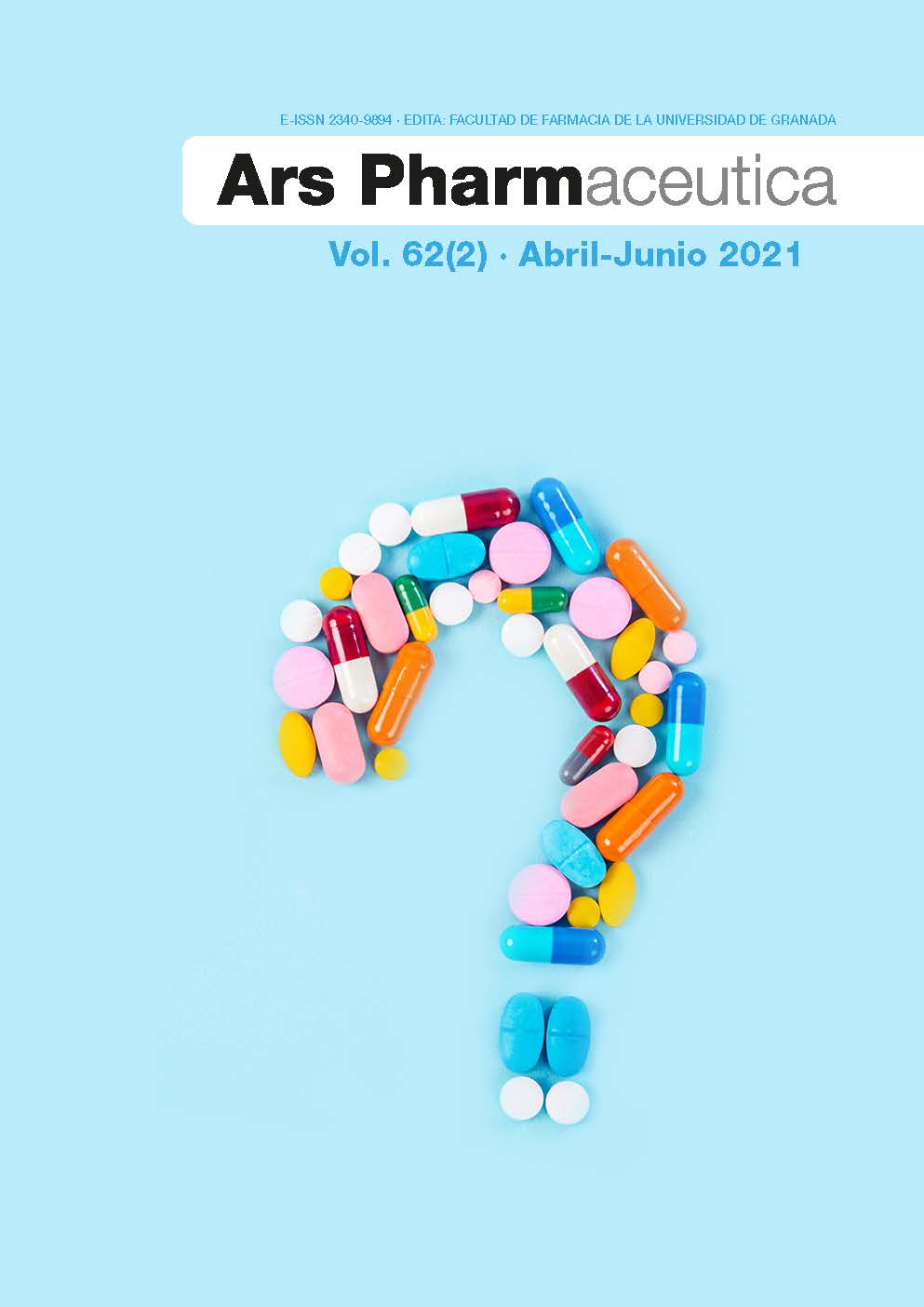Evaluation of disinfectants for use in the pharmaceutical environment
DOI:
https://doi.org/10.30827/ars.v62i2.15713Keywords:
disinfectants, effectiveness, usage tests, poured plateAbstract
Introduction: Disinfectants are used in pharmaceutical companies to guarantee the reduction or elimination of microorganisms that may be present in production lines, equipment, personnel or the environment. Although the manufacturer guarantees their effectiveness, it is necessary to test them in the pharmaceutical environment where they are to be used.
Method: Three disinfectants were evaluated, NDP-Surfaplus in 70% concentration, NDP-Surfaclin in 2% and 0,5% concentration and Tristel Jet gel activated at 0,12% concentration. Swabs were performed before and after the application of the disinfectant to sections of wall surfaces, floors, marble plateaus and stainless-steel sinks. From each surface the sections that were most difficult to carry out the cleaning and disinfection processes were chosen. The counting method used was the poured plate method.
Results: The disinfectants were shown to meet the stipulated acceptance criteria with a 90% reduction in the initial microbial population, except for the 0,5% concentration of the NDP-Surfaclin disinfectant. A greater number of microorganisms were isolated on surfaces that had a tendency to form pores due to erosion from cleaning and disinfection processes, and it was also shown that disinfectants had a better activity on stainless steel surfaces.
Conclusions: The effectiveness of disinfectants in the pharmaceutical environment of the formulation line was demonstrated, approving their use for cleaning and disinfection processes. The best-performing disinfectant was NDP-Surfaplus at the 70% concentration.
Downloads
References
Luppens SB, Reij MW, van der Heijden RW, Rombouts FM, Abee T. Development of a standard test to assess the resistance of Staphylococcus aureus biofilm cells to disinfectants. Appl Environ Microbiol. 2002 Sep;68(9):4194-200. doi: 10.1128/aem.68.9.4194-4200.2002
Ronner AB, Wong ACL. Biofilm Development and Sanitizer Inactivation of Listeria monocytogenes and Salmonella typhimurium on Stainless Steel and Buna-n Rubber. J Food Prot. 1993;56(9):750-758. doi: 10.4315/0362-028X-56.9.750.
Fleitas, A. Compuestos sanitizantes y sus propiedades. Limpieza y sanitización en plantas de alimentos. 1994. Bogotá, Asociación Química Colombiana.
Marritot, N. Marrito, N. Principios de higiene alimentaria. Editorial Acribia S.A Zaragoza, España, 2003, pp 153-167.
Rodríguez C. Validación de desinfectantes usados en las áreas de producción de la industria farmacéutica en Bogotá. Universidad Javeriana, Facultad de Ciencias, Bogotá,2002, 89
Medina Córdoba L, Valencia Mosquera K Ligia L. Evaluación de la eficacia de un desinfectante de alto nivel, a base de peróxido de hidrogeno, empleado en la esterilización de dispositivos e instrumentos hospitalarios. Pontificia universidad javeriana Facultad de ciencias Carrera de microbiología industrial 2008 disponible en:http://bibliomed.usac.edu.gt/sites/default/files/documentos/guia_vancouver_2016.pdf
United States Pharmacopeia 40, National Formulary 35. Test 1072 Antisépticos y desinfectantes, Rockville, Md., USA. The United States Pharmacopeial Convention, Inc. 2017. (versión electrónica).
Martínez, J.E 2006 What is Disinfectant Validation? Pharmaceutical Technology. 2006; 30(6)
United States Pharmacopeial 40. National Formulary 35Rockville, Md., USA. Convention, Inc. 2017. (versión electrónica). Test 1116. Control microbiológico y monitoreo de ambientes de procesamiento aséptico. Págs. 1571-1572
United States Pharmacopeial 40. National Formulary 35. Test 61. Limite microbiano Rockville, Md., USA. The United States Pharmacopeial Convention, Inc. 2017. (versión electrónica). Págs.172-178
United States Pharmacopeial 40. National Formulary 35Rockville, Md., USA. Convention, Inc. 2017. (versión electrónica). Test 1116. Control microbiológico y monitoreo de ambientes de procesamiento aséptico. Págs. 1571-1572
Davies, D. G., Parsek, M. R., Pearson, J. P., Iglewski, B. H., Costerton, J. W., y Greenberg, E. P. (1998) The involvement of cell-to-cell signals in the development of a bacterial biofilm, Science 280, 295-298.
Diomedi A, Chacón E, Delpiano L, Hervé B, Jemenao M.I, Medel M et al. Antisépticos y desinfectantes: apuntando al uso racional. Recomendaciones del Comité Consultivo de Infecciones Asociadas a la Atención de Salud, Sociedad Chilena de Infectología. Rev. chil. infectol. [Internet].2017; 34(2):156-174.Doi10.4067/S0716-10182017000200010.
McDonnell G, Russell AD. Antiseptics and disinfectants: activity, action, and resistance. Clin Microbiol Rev. 1999 Jan;12(1):147-79. Erratum in: Clin Microbiol Rev. 2001 ;14(1):227.
Sánchez-Saldaña L, Sáenz Anduaga E. Antisépticos y desinfectantes Dermatología Peruana 2005; 15 (2): 82-103.
Da Silva M, Ning C, Ghanbar S, Zhanel G, Logsetty S, Liu S. Evidence that novel quaternary compound and its organic N-chloramine derivative do not select for resistant mutants of Pseudomonas aeruginosa. J Hosp Infect 2015; 91 (1): 53-8.
Omidbakhsh N. Theoretical and experimental aspects of microbicidal activities of hard surface disinfectants: are their label claims based on testing under field conditions? JAOAC Int 2010; 93 (6): 1944-51.
Downloads
Published
How to Cite
Issue
Section
License
Copyright (c) 2021 Ars Pharmaceutica (Internet)

This work is licensed under a Creative Commons Attribution-NonCommercial-ShareAlike 4.0 International License.
The articles, which are published in this journal, are subject to the following terms in relation to the rights of patrimonial or exploitation:
- The authors will keep their copyright and guarantee to the journal the right of first publication of their work, which will be distributed with a Creative Commons BY-NC-SA 4.0 license that allows third parties to reuse the work whenever its author, quote the original source and do not make commercial use of it.
b. The authors may adopt other non-exclusive licensing agreements for the distribution of the published version of the work (e.g., deposit it in an institutional telematic file or publish it in a monographic volume) provided that the original source of its publication is indicated.
c. Authors are allowed and advised to disseminate their work through the Internet (e.g. in institutional repositories or on their website) before and during the submission process, which can produce interesting exchanges and increase citations of the published work. (See The effect of open access).























